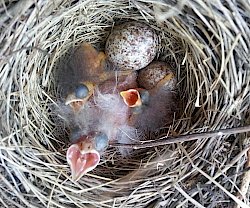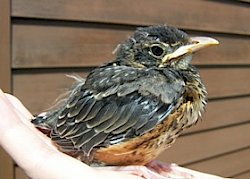Wildlife Animal Tips & Resources
Our love of animals extends beyond the domesticated.
We are fortunate there is a great resource in the area in case a wild animal in need of help is found.
Appalachian Wildlife Refuge helps injured and orphaned wild animals covering all of western NC. They take any wild animal other than what the state deems are vector species (skunks, raccoons, bats, coyotes and fox). They can only take deer that still have their spots and bear that are under 30 lbs Otherwise they take it all - squirrels, possums, groundhogs, rabbits, beaver etc, all birds, all reptiles, all amphibians.
Their phone number is (828) 633-6364 ext.1. Their hours are 10:00am - 6:00pm, 7 days a week.
An animal needs to be rescued if...
- The animal has been attacked.
- The animal was in contact with cat saliva.
- Flies/insects are on the animal.
- The animal is in obvious danger that cannot be avoided without intervening directly.
- The animal’s mother is known to be dead.
- It has been hit by a car.
- *The animal appears dazed, confused, or in shock.
If an animal needs to be rescued, then...
- Place it in a box in a warm, dark, quiet area.
- Keep children and pets away from animal.
- Do not give food/milk, water; if an animal is dehydrated, this can kill it.
- Contact CSAH for medical attention if injury is evident or contact a rehabilitator in your area and wait for further instructions.
*Often times, if a wild animal is in shock (flew into a window for example) with no other obvious trauma, putting it in a dark, quiet place for ~45 minutes will give it a chance to come-to. If possible, place it in a cardboard box with holes, and tape it shut. When it is time to check on the animal, be sure to take it to the release site first!
Wild Animal Tips
Please take a moment to read the following important tips to help ensure an accurate understanding of wildlife in need, when to intervene, and what to do.
Nestling Baby Birds:
 If a baby bird has fallen out of the nest and appears unhurt, try to put it back into the nest. If it is cold, warm it with your hands and then place into the nest.
If a baby bird has fallen out of the nest and appears unhurt, try to put it back into the nest. If it is cold, warm it with your hands and then place into the nest.- If you cannot place the bird into nest, one can be made and tied to the tree closest to the original nest. Simply use a margarine tub, or strawberry basket lined with tissues, paper towels, or tee-shirt and tie it to the tree. Do not line the new nest with grass, mud, or a towel. The grass and mud can carry parasites and baby birds can get their nails caught in the towels.
- If the original nest has fallen out of the tree, try to place it back into the tree in a secure place.
- IT IS UNTRUE THAT THE MOTHER WILL NOT COME BACK IF THE BABY HAS BEEN TOUCHED!
- Once the bird has been placed in the nest, observe from a distance, out of sight, and see if the mother returns within 2 hours. If not, the baby will need to be rescued.
 Fledgling Baby Birds:
Fledgling Baby Birds:
- Fledgling birds usually hop out of the nest and live on the ground unable to fly for several days. This is a normal and natural progression. The parents will continue to care for the bird while it is learning to fly.
- Please keep children and pets away from the bird until it can fly away.
Cottontail Rabbits:
 These sensitive creatures can be on their own at 3-4 weeks of age; when they reach the size of a tennis ball, they are generally on their own.
These sensitive creatures can be on their own at 3-4 weeks of age; when they reach the size of a tennis ball, they are generally on their own.
- Cottontails are on their own when they are 4 inches long.
- Die of stress very easily.
- If you know where the nest is, the rabbit can be placed back into nest. The mother will only visit the nest approximately 2 times per day, in the early morning and at dusk, to avoid bringing predators to her babies. You will most likely will not see the mother because she will not approach. Place the rabbit in the nest, and then take a string, yarn, or sticks and make a criss-cross over the nest. Leave the nest alone for 24 hours. Recheck and see if the sticks have been disturbed. If they have been, then the mother is taking care of the babies. If not, then the baby in fact needs to be rescued.
- For rabbits, cat saliva is toxic. A cottontail rabbit will need to be seen by a veterinarian for oral antibiotics as a minimum for treatment.
 Opossums:
Opossums:
- Opossums can be on their own when they are 10 inches long, not including the tail.
- However, if the opossum appears fat, healthy, and alert, it does not need to be rescued.
- If you have to “chase down” the opossum to catch it, it does not need to be rescued.
Squirrels:
 If a squirrel has fallen out of nest, place a box lined with soft material at the base of the tree the squirrel fell out of. Observe from a distance for 2 hours and see if mother comes to retrieve squirrel.
If a squirrel has fallen out of nest, place a box lined with soft material at the base of the tree the squirrel fell out of. Observe from a distance for 2 hours and see if mother comes to retrieve squirrel.- If the tree has been cut down, then place box with squirrel at the tree nearest to the fallen tree.
- If a baby squirrel walks up to you looking for food, or is afraid, then it needs to be rescued.
Turtles:
 Like most wildlife, Eastern Box Turtles are not in need of rescuing unless you see visible injuries.
Like most wildlife, Eastern Box Turtles are not in need of rescuing unless you see visible injuries.- Often seen attempting to cross a busy road, all they need is a little help: place the turtle on the other side of the road, 12 feet beyond, in the same direction that it was attempting to go.
- It is important not to set it back where it started. Turtles have internal homing devices; it knows exactly where it's going and will simply try crossing the road again putting itself in manmade danger.
- If the Box Turtle does show signs of distress or injury, gently pick up the turtle, keeping your hands towards the back half of the shell.
- Gently place the turtle down- although they have sturdy shells, they can crack/break.
- Be as specific as possible with the location it was found, this will help the rehabilitator release it properly. Although they can live over 50 years in the wild, they roam in a relatively small area they call home.
Helpful Resources & Contacts:
Here is information about Wildlife Rehabilitators; these volunteers have special training and the necessary state permits allowing them to rehabilitate wildlife; please do not attempt to treat or care for injured or orphaned wild animals on your own.
All mammals and reptiles are protected by state laws. Note: Rabies Vector Species in NC are raccoon, fox, bat, skunk, bobcat, wolf, and coyote; these species cannot be rehabilitated by anyone in NC. Even orphaned suckling animals of these species have been known to transmit rabies and rehabilitators are not permitted to rehabilitate them. Minor contact with these animals is dangerous for you and the injured animal based on rabies laws; call Wildlife Resources Commission or Asheville City Police for Animal Control if you have encountered a situation with one of these rabies vector species. To report a concern involving rabies vector wildlife, call the Wildlife Resources Commission at 919-707-0010.
Injured Deer or Black Bear: Deer and Black Bear have specific regulations associated with their rehabilitation. Please call The Wildlife Enforcement Division directly in the case of injured deer or black bear at (1800) 662-7137.
Injured Endangered/Threatened Species: If the injured animal can be identified as an endangered or threatened species, contact the Wildlife Enforcement Division at 1-800-662-7137 or the US Fish and Wildlife Service at (919) 856-4786.
Resource Links:
Resources provided by the North Carolina Wildlife Resources Commission
Cookies on this website are used to both support the function and performance of the site, and also for marketing purposes, including personalizing content and tailoring advertising to your interests. To manage marketing cookies on this website, please select the button that indicates your preferences. More information can be found in our privacy policy here.

